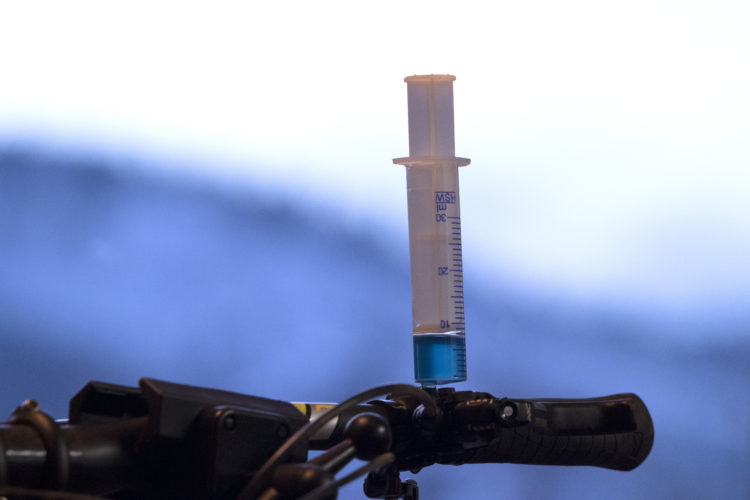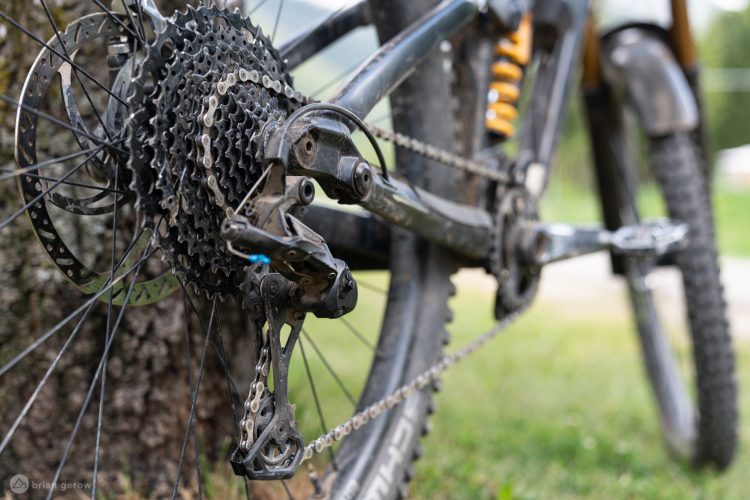A bicycle chain needs lubricant to overcome mechanical resistance, prevent rust and wear, and keep your drivetrain in tip-top condition. If not used properly, the same lubricating compounds designed to protect and enhance drivetrain performance are inherently at odds with the very purpose for which they were created. To reap the rewards without suffering the strikes, properly lubing your chain should be done in moderation, as you delicately balance the amount of lube, type, and frequency of application in accordance with chain use in varying conditions.
Note: the intricacies of chain lube use is a topic of much debate among mountain bikers. As there is no cookbook recipe, use the following as a guide to explore what works best for you.
How often should I apply chain lube?
The frequency at which chain lube should be re-applied is like any other component’s maintenance interval: it depends on how often you ride, in what conditions, the type of lube used, and your attention to chain care between re-lubing. For some, this means re-applying lube every day, while for others, it may be once a month or more. Theoretically speaking, frequent riding using a dry lube in wet, muddy conditions, seldomly wiping the chain down between rides, will require a shorter interval between application than less frequent riding using a wet lube in those same conditions with a good wipe after each ride. Over-lubing can also be detrimental, as excess lube attracts dirt, forming a gritty paste which grinds down chain components and other drivetrain bits. Appearance, time, or distance are not as reliable as sound (grinding, creaking, squeaking, squealing) as an indicator for when a chain needs to be lubed.
To degrease or not to degrease?
Routine use of degreaser on a chain prior to application of fresh lube as best practice is debatable. Again, the real world answer is… it depends. While degreaser rids the chain of grime, it also strips it of the very substance your chain needs. For most day in, day out maintenance, simply wiping down the chain with a dry rag or scrubbing the chain with a dry toothbrush between every ride and before application of fresh lube will suffice.
Some insist on using degreaser as often as they re-lube the chain for various reasons, but this involves careful consideration lest you defeat the purpose of lube. When using degreaser, you need something that reaches every nook and cranny of the chain, as that is where bicycle-specific lube is made to penetrate. A toothbrush works well along with plenty of elbow grease (see what I did there?). Once you’ve scrubbed it with degreaser, thoroughly rinse the chain with water and let completely dry before applying lube. Omitting the rinse and dry step leaves grime and water on the chain, which cuts and/or suspends actions of new lube.
I’m of the opinion that degreasing is mostly unnecessary, save for the following scenarios:
- when switching from dry to wet lube (or vice versa)
- when switching brands of lube
- on a new chain (see below)
How do I apply chain lube?
The perfect amount of lube is enough to overcome the resistance set forth by the rollers, plates, and pins, and prevent rust to those parts, without attracting excessive dirt. Start by applying one drop per link (each roller) as you back pedal the chain through the drivetrain, and take note where you started to avoid redundant lubing. Slowly run the chain up and down the cassette to help distribute the lube as far down into the rollers and pins as possible. With a clean, dry rag, grip the chain and back pedal, wiping off excess lube. Wet lubes typically require a second wipe, so remember to hit it again with a rag at the trailhead.
Most sources recommend some amount of wait time between application and tearing off into the sunset. Dry lubes typically require a few hours to set up, while a wet lube needs less. The best advice I can offer is to plan ahead, lube up the night before, and always refer to the manufacturer recommendations. That said, if you’re in a pinch, squirt it on, wipe it down, and get going!
Can I apply one type of lube over another?
It’s not as if your chain will explode, but application of, say, a dry lube over wet is unpredictable at best. While it’s possible the new lube penetrates the chain and sets up properly, it is also very likely that it will not, and will become suspended by old lube. Changing between types of lube is a case where using a degreaser may be warranted.
Should I apply lube to a new chain?
New chains come packaged with some sort of lubricant and, although some are excessively slimy and sticky, attracting way more dirt than any lube I’ve used, they can be used without degreasing and lubing. I recommend using a rag lightly dowsed with degreaser to wipe off the outer chain before use.
What type(s) of lube do I need?
As expansive as the chain lube market is and because drivetrain maintenance rituals differ so greatly, I don’t advocate one lube over another. What works best is a matter of personal experiment. That said, there are some basic differences between types of lube that suit certain conditions.
Dry lube has a lighter consistency, goes on wet, and then dries, leaving behind a protective, lubricating layer (wax, Teflon, ceramic). Dry lubes do not stand up well to the rigors of mud and wet weather riding, but they do do well at not attracting dirt in dry conditions. The down side to dry is that it must be applied more frequently than wet lube.
Wet lube has a stickier, more viscous consistency, acting as a water repellent, and is best used in wet or muddy conditions. Wet lube typically lasts longer than dry, but because it stays wet on the chain, it attracts more dirt in dry, dusty conditions.
While strict wet and dry lubes mark the extremes of lube types, many manufacturers market options in between, such as lubes for wet and dry conditions, 2-in-1 self-cleaning lubes, one for on-road and one for off, and… the list goes on.
Historically, the discussion surrounding types of lubes have revolved around using wet lube in wet conditions and dry lube in dry conditions, but these are simply guidelines. Using a dry lube in February riding Vancouver, B.C.’s North Shore won’t disintegrate your chain anymore than a wet lube will in Moab, but you must appreciate the limits of each lube, what they’re best suited for, and adjust your maintenance habits to get the most out of any particular lube.
Do I have to use bike-specific lube?
Nope, but unless you have the time, patience, an obsession with chemistry experiments, or think The Man is trying to keep you down, what’s the point in not using a bike-specific lube? I’m sure someone’s cousin’s roomate’s uncle has been using motor oil since Repack and maybe, in a pinch, you’ve even shot some WD-40 with no issue, but generic and household products are not long-term solutions for keeping your chain in proper order. Non-specific lubes are either too light to stay put, too heavy to properly penetrate, too sticky, too watery, too… you get the picture. Bicycle-specific lube is designed with your chain’s best interest in mind. This means it was made thin enough to drip on and penetrate the rollers and pins, yet thick enough to set up and remain, all while preventing rust and resisting dirt, water, and mud (depending on lube type) as much as possible. You don’t have to use bike-specific lube, but you should.

The Take Away
Throw some shop towels in the car and develop the habit of wiping down your chain after every ride. Sound is the best way to determine when lube should be reapplied. Routinely degreasing a chain is not necessary, but if you insist, thoroughly rinse and dry the chain prior to applying lube. Use chain lube that matches your conditions, wipe off excess after application, and allow at least a few hours for the lube to set up. Stock up on a handful of lubes with different properties, and cycle through them over the next year to find which suits you (and your chain) the best.
While it is by no means comprehensive, here’s a list of many well-respected bicycle-specific chain lube brands to get you started:
- Boeshield T9
- Dumonde Tech Lite Chain Lube
- Finish Line Dry Lube
- ProGold ProLink
- Squirt Long Lasting Dry Lube
- White Lightning Clean Ride
Your Turn: Share your favorite chain lube, or favorite lubing technique/time interval, with us in the comments section below!
























